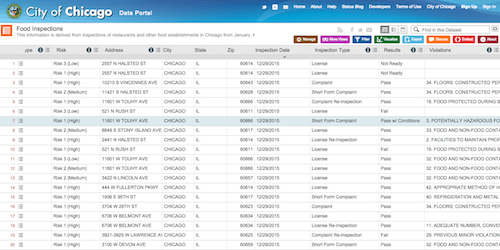An Important and Completely Unappetizing Map
We all want to eat healthy, but usually that includes things like fresh vegetables and less processed food. You can add restaurants with clean floors to that list. Perhaps thWe all want to eat healthy, but usually that includes things like fresh vegetables and less processed food. You can add restaurants with clean floors to that list. Perhaps that’s an obvious requirement, but a kitchen’s cleanliness is rarely apparent to patrons. That’s why health departments in many localities have frequent inspections, with the results available to the public. It’s not always so easy to find and view a restaurant’s score, but plotting this open data on a map using BatchGeo can expose problem places near you.
View Chicago Health Code High Risk Failed Inspections in a full screen map
That’s what we did with Chicago’s health department records, available on its open data portal. We loaded all 2,500 high risk failed inspections into BatchGeo, allowing Chicagoans to gain some insights from making the data geographically browsable.
Look for Overall Trends
Our map automatically tries to show all the data at once. Since the 2,500 markers would be dense and overlapping, by default BatchGeo enabled the map clustering option. While that can be disabled, it’s useful for gaining a glimpse of the data below. For example, we can tell that in most neighborhoods about half of violations were due to canvassing, the periodic inspections performed by the health department. About 15-20% come directly from complaints and about the same number are found when applying for a license.
You can also mix and match the grouping fields to get additional insights. Just use the menu in the lower left to select a field and one or more values. For example, you might be more interested in day care and other children’s facilities than restaurants. Select Facility Type from the grouping menu, then click the three types that correspond to those places. Now switch the grouping to Inspection Type and you’ll only see the data for day cares. Here we can tell that, for this type of facility, license and canvassing make up an even great portion of the violations.
Interactive Maps Made Easy
Sign Up NowFind Nearby Health Code Violations
You’re more likely to eat near where you live or work. Every BatchGeo map optionally includes a store locator feature to find your closest plotted point on the map. Let’s say you live at Wrigley Field, 1060 W Addison St. Put the address into the search bar in the upper right of the map. You’ll be taken to the three violations in 2015 at the stadium itself, which has a number of food vendors.
Or let’s say you’re President Obama going home to Chicago. Plot in his family’s address at 5046 South Greenwood Avenue and you can see Windy’s Deli had some issues with refrigerator temperature.
How We Found the Data

 The City of Chicago Data Portal has hundreds of available datasets, updated regularly. One of its most popular is the food inspections data we used, which contains every single inspection from 2010 to now. In addition to failed inspections, you’ll find every check that passed, as well as every level of risk. In our map, we only show high risk failed inspections from 2015. We didn’t have to crunch that data ourselves, the Chicago data portal allows us to filter the data.
The City of Chicago Data Portal has hundreds of available datasets, updated regularly. One of its most popular is the food inspections data we used, which contains every single inspection from 2010 to now. In addition to failed inspections, you’ll find every check that passed, as well as every level of risk. In our map, we only show high risk failed inspections from 2015. We didn’t have to crunch that data ourselves, the Chicago data portal allows us to filter the data.
We employed three different filters to get the data we needed. First, we included start and end dates for the inspections—January 1, 2015 to December 31, 2015. Next, we only wanted results that included a Fail. Finally, we wanted the risk to be high, to weed out leaky faucets and other low risk findings that also result in failing a health inspection. Finally, there’s an option to export the filtered data in a number of formats, including a CSV for Excel, which we can easily turn into a BatchGeo map.
Find Your Own City Data
This map and data works great if you live in Chicago. What about if you live somewhere else? Your local health department likely makes its records available online. You might also check with Socrata, the company whose software powers Chicago’s site, as well as several others. Socrata maintains this list of public data portals, itself powered by Socrata.
You’ll find other ideas, including mapping Wikipedia lists, in our guide to mapping open data.
